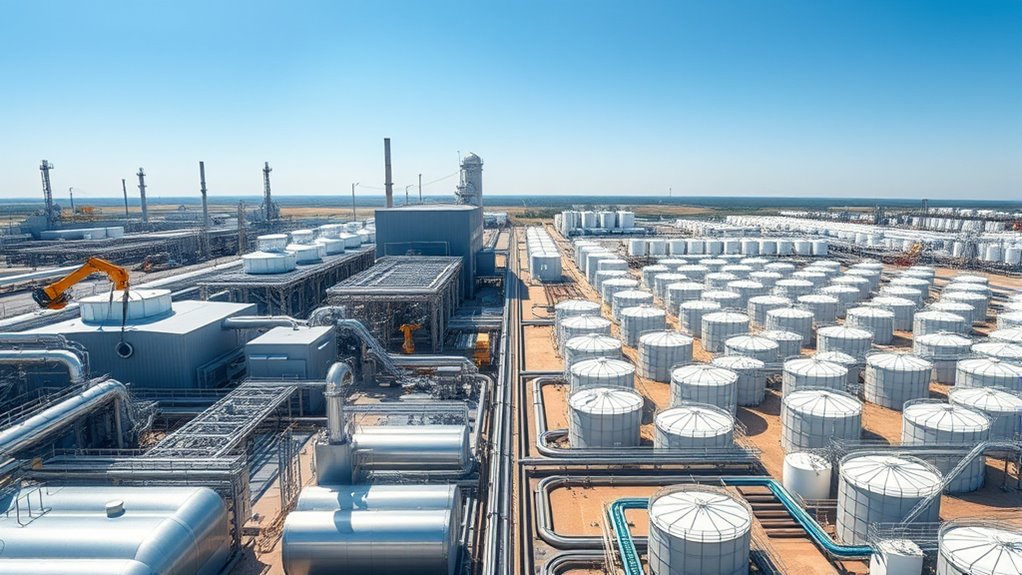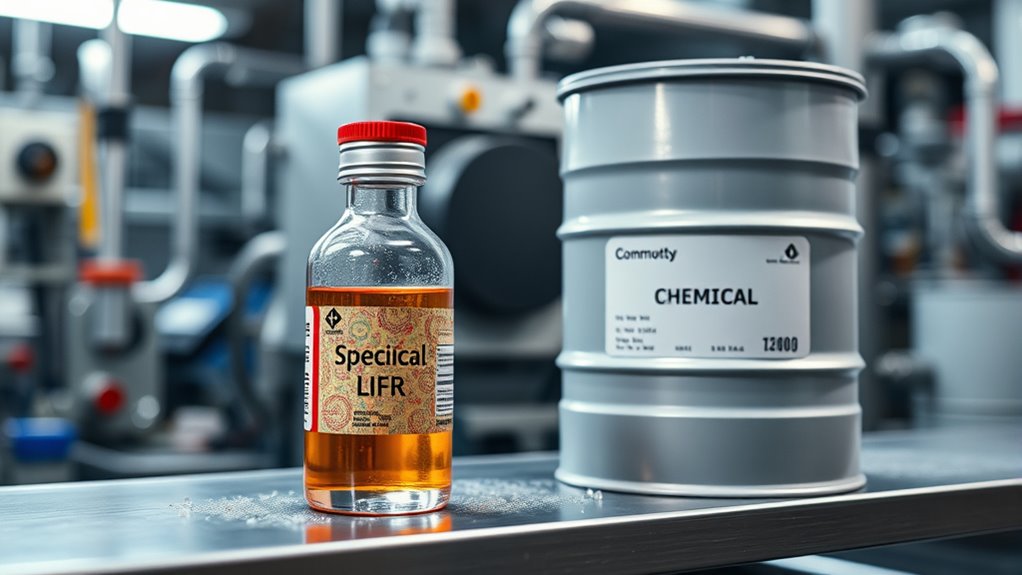Specialty chemicals are made in smaller quantities, tailored for specific uses, and often involve complex formulations, providing high-value solutions and technical support. In contrast, commodity chemicals are produced in large volumes with standardized processes for broad industrial applications, usually at lower margins. Understanding these differences helps you see how each serves different markets and industries. If you want to explore how these distinctions impact their production and application, there’s more to uncover ahead.
Key Takeaways
- Specialty chemicals are produced in smaller batches with tailored formulations, while commodity chemicals are made continuously at high volumes.
- Specialty chemicals offer higher profit margins through customization and technical support; commodities focus on low-cost, standardized production.
- Specialty chemicals serve niche markets like electronics and pharmaceuticals; commodities are used as raw materials across broad industries.
- Market growth for specialty chemicals is faster (around 5-6%) compared to commodities (2-3%), reflecting their innovation-driven nature.
- Specialty chemicals involve complex R&D and formulation processes; commodities rely on straightforward, large-scale manufacturing.
Definition and Classification of Chemicals

Chemicals can be broadly classified based on their production scale, application, and complexity. You’ll find three main categories: commodity chemicals, specialty chemicals, and fine chemicals.
Commodity chemicals are produced in massive quantities, are relatively simple, and serve as raw materials for various industries—think ammonia or ethylene oxide. They’re generally interchangeable between suppliers due to their standardized nature. These chemicals often form the backbone of large-scale manufacturing processes.
Specialty chemicals, on the other hand, are made in smaller batches, tailored for specific functions, and often involve complex formulations. They add particular performance qualities to products like adhesives, cosmetics, or lubricants. Manufacturing processes for specialty chemicals require greater flexibility and innovation due to diverse product requirements. Their customized nature makes them more difficult to standardize across different suppliers.
Fine chemicals are highly pure substances created in small amounts, often acting as intermediates or active ingredients. This classification highlights their distinct roles, manufacturing processes, and market characteristics within the broader chemical industry. These compounds frequently demand strict quality control and specialized production techniques.
Production Methods and Scale

Production methods and scale differ markedly between specialty and commodity chemicals. You’ll find specialty chemicals are produced in smaller batches to ensure high quality and customization. These batches often progress from pilot plants to semi-commercial runs before full production, with multiple intermediate steps to maintain product integrity. This careful scaling process helps manage complex chemistries and strict quality controls. Additionally, the batch processing approach used in specialty chemical production allows for greater flexibility in formulation adjustments. In contrast, commodity chemicals are made on a large, continuous scale designed for high-volume output and cost efficiency. Their plants focus on maximizing throughput with standardized processes that require less flexibility. Specialty chemical production relies on batch processing, which allows for adjustments and precise control, whereas commodity chemicals use continuous processes for consistency and economy of scale. Scale-up in specialty chemicals involves detailed steps to maintain specifications, while commodity chemical scale-up is straightforward due to standardized methods.
Customization, Technical Support, and Formulation

When it comes to differentiation in the chemical industry, customization and technical support play crucial roles in shaping market positioning. With specialty chemicals, you tailor formulations for specific performance needs, controlling composition and properties precisely to meet demanding applications. This often involves extensive R&D, creating unique products for niche markets. Revenue and profit margin data can highlight how these tailored solutions contribute to higher margins and customer loyalty. Additionally, the ability to adapt formulations swiftly to changing customer requirements demonstrates flexibility and responsiveness, which are key advantages of specialty chemicals. Meanwhile, your technical support includes troubleshooting, formulation advice, and on-site assistance, fostering strong customer relationships. These services help optimize product performance and accelerate development cycles. In contrast, commodity chemicals rely on standardized formulations with minimal customization. They’re simple, single-ingredient substances produced at scale, with limited technical support due to their generic nature. This focus on volume and cost efficiency means customization and support are secondary, positioning specialty chemicals as high-value, innovative solutions.
Market Dynamics and Economic Factors

Understanding market dynamics and economic factors is essential for evaluating the growth potential of specialty versus commodity chemicals. You’ll find that specialty chemicals tend to offer higher profit margins, thanks to their unique formulations and value-based pricing.
While commodity chemicals are produced in larger volumes with lower margins, their prices fluctuate more due to supply and demand. Specialty chemicals are growing faster—around 5-6% annually—driven by emerging economies and technological innovations, whereas commodity chemicals grow at 2-3%. Additionally, the evolving landscape of cybersecurity concerns, particularly around digital supply chain management, underscores the need for resilient and secure operational frameworks in both sectors.
Higher barriers to entry protect specialty chemical companies from intense competition, leading to increased market share and customer loyalty. Both sectors require resilient supply chains, but specialty chemicals benefit from evolving regulations and innovation, positioning them for more significant long-term growth compared to the more price-sensitive commodity segment.
Applications and Industry Usage

Specialty chemicals play a critical role across diverse industries, enabling technological advancements and improving product performance.
In electronics and high-tech sectors, you rely on specialty chemicals for manufacturing silicon wafers, semiconductors, and circuit boards. They support processes like gas-phase etching, thin film deposition, and copper plating, ensuring precision and miniaturization.
In mining, you use specialty chemicals to enhance ore grinding, mineral separation, and dust control, boosting efficiency and safety.
For pharmaceuticals, these chemicals help purify raw materials, improve drug solubility, and meet strict regulatory standards.
In construction, they add durability and weather resistance to paints and concretes.
In food and personal care, they preserve freshness, enhance appearance, and improve product stability.
Their versatility makes them essential for innovation and performance across industries.
Additionally, the use of specialty chemicals in manufacturing processes often requires precise control over chemical properties to meet industry standards and ensure safety.
Frequently Asked Questions
How Do Regulatory Requirements Differ for Specialty and Commodity Chemicals?
You’ll find that regulatory requirements differ mainly in scope and detail.
For specialty chemicals, you must follow strict standards, maintain extensive documentation, and ascertain safety for specific applications like pharmaceuticals or cosmetics.
Commodity chemicals, however, focus more on environmental regulations, safety during large-scale production, and emissions.
Regulations for specialty chemicals often involve multiple agencies and ongoing updates, while commodity chemicals are governed mainly by environmental rules and volume-based thresholds.
What Are the Environmental Impacts of Manufacturing Each Type?
Environmental impacts evoke essential concerns. You’ll find specialty chemicals contribute markedly to carbon emissions, VOCs, and hazardous waste, challenging ecosystems and environments.
Meanwhile, commodity chemicals cause extensive energy consumption, greenhouse gases, and wastewater issues from large-volume production. Both threaten water, air, and land, but specialty chemicals often demand more complex, careful processes, whereas commodity chemicals focus on mass production.
You must consider these impacts when managing manufacturing methods to minimize environmental harm effectively.
How Does Supply Chain Complexity Vary Between Them?
You’ll find supply chain complexity varies greatly between specialized and commodity chemicals. With specialty chemicals, sourcing involves niche raw materials, making the supply chain more fragmented, less visible, and prone to disruptions.
You’ll deal with customized manufacturing, strict handling requirements, and agile distribution.
In contrast, commodity chemicals have standardized inputs and processes, enabling streamlined sourcing, predictable logistics, and high-volume production. This simplicity reduces risks but also limits flexibility.
What Are the Typical Lead Times for Producing Each Type?
Imagine production schedules like trains on different tracks. For specialty chemicals, lead times are like a slow, winding journey—longer and variable due to customization and complex processes.
In contrast, commodity chemicals run like high-speed trains—shorter, predictable, and efficient because of standardized production. You’ll find specialty chemicals often take more time, while commodity chemicals move quickly through large-scale, streamlined manufacturing.
How Do Patent Protections Influence Market Competition?
Patent protections directly impact market competition by granting exclusive rights, allowing you to control pricing and market share temporarily. They encourage innovation by rewarding R&D efforts, but can also create barriers for new entrants, limiting competition.
You must carefully manage your patent portfolio and legal strategies to maximize protection while avoiding anti-competitive practices. Ultimately, well-handled patents can foster innovation and ensure market stability, but excessive protection might hinder broader competition.
Conclusion
Understanding the difference between specialty and commodity chemicals is like steering through a vast garden—you’ll find the specialty plants crafted with care for unique needs, while commodity plants grow abundantly and serve as the backbone of many industries. By recognizing their distinct roles, production methods, and market influences, you can make smarter choices. Ultimately, knowing these chemicals is like tending your own garden, where each type plays a crucial part in the ecosystem of industry and innovation.









